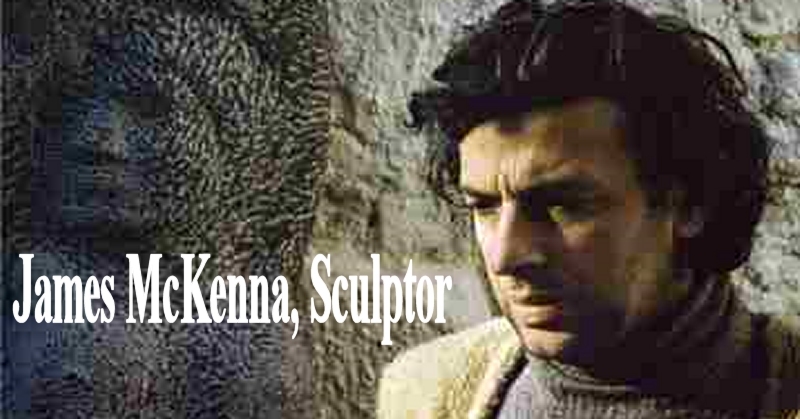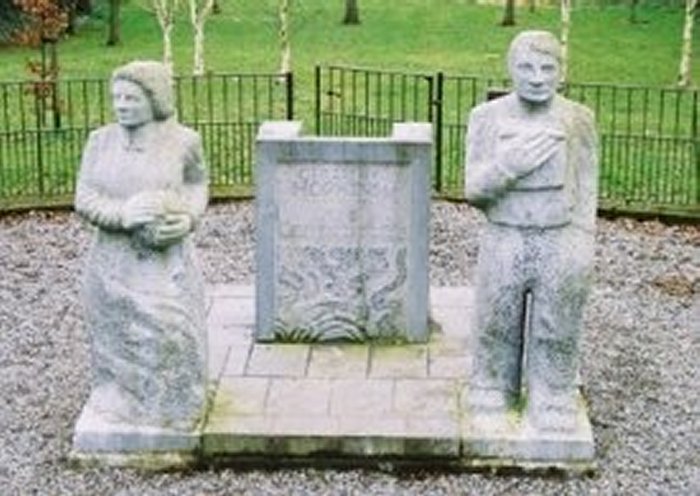
James McKenna, Irish Stone Sculptor (1933 - 2000)
- James McKenna, above all else, a Sculptor, an Irish Stone Sculptor.
- Brian Fallon, Art Critic The Irish Times, reviews McKenna's life of Committment and Dedication to the Arts
- Farewell to Sculptor James McKenna from The Hopkins Festival Committee. McKenna died in 2000 and is buried
in Kilbelin Cemetary outside Newbridge, Co. Kildare. -
Oisin Caught In A Time Warp
, or, Oisin in Dhiaidh ne Féinne, a magnificent James McKenna Sculpture on permnent display in Arus Bridge, County Kildare Administrative Centre in Naas, Co. Kildare
- In October 2002, two years after his untimely death, friends gathered in Riverbank Arts Centre to celebrate the memory of this fine spirit. James McKenna, A Celebration (edited by Desmond Egan) was launched.
- The sad Tale of The Hazelwood Group. James McKenna is dead— having spent most of his last years in abject poverty—and his magnificent Hazelwood piece,' Ghost Riders in the Sky', reduced to dust through neglect and indifference.
Art Critic,
The Irish Times.
Stone Sculptor, James McKenna, lived for his Art
Growing up in Co. Wicklow, JamesMcKenna was educated at Kilcool National School, Bray Technical School and the National College of Art and Design, (now the NCAD) in Dublin from 1950 - 1955. He qualified with a Diploma in Sculpture and won a scholarship to Florence.
James McKenna, Irish Stone Sculptor
McKenna first exhibited with the Exhibition of Living Art in 1957 and with the Sculptor's Institute Exhibition in 1958. He helped found the Independent Artists Group, who held their first exhibition in June 1960. He was chosen to give what amounted to an exhibition within an exhibition in that show. It featured ten of McKenna's works.
Arising out of this, he was awarded a Macaulay Scholarship to Italy. During the 1960's he continued to exhibit with the Independent Artists. Besides exhibiting annually at the GM Hopkins Summer School since its inception in 1987. James's sculpture was included in Exhibitions in Kilmainham Jail. His 'Warriors of Banba'
created a sensation exhibited in Dublin Castle Upper Yard in September 1999.
McKenna's "Famine Family
" was first exhibited at Hopkins (July 1998) and stunned visitors. It is eight feet high, made of 4000 years old black oak. The piece has now been installed in the grounds of Athy Hospital— itself a refuge for famine victims of the 1840s.
In the late '60s and '70s, James McKenna campaigned vigorously, with his colleagues for a democratisation of the Arts Council. Some of his work appeared in Project Arts Centre shows.
With his 'Rising Ground' Drama Group,
James staged plays in the Project Theatre.

The Gerard Manley Hopkins Commemorative Sculpture (Limestone): Commissioned by the Gerard Manley Hopkins Society. Installed in Monasterevin 1991.
The SCATTERIN'
In 1959, he wrote his first play 'The Scatterin
' which was the hit of the Dublin Theatre Festival in 1960. The world's first Rock Musical
. featured stylised acting, dancing and the use of masks.
The World's First Rock Musical
The Scatterin later transferred to London. It was hailed as a classic of its kind and has been performed regularly ever since. This is how John Ryan assessed this play in 1975 (Remembering How We Stood - 'a musical play which was to be a theatrical landmark, and, aruably, the world's first rock musical.'
When McKenna presented his 'Wreck of the Deutschland' at the Summer School (1998), the stage itself was grand enough for a grand opera; his fine script; the faltering actors; James at the helm of the ship, turning the wheel. Then, dissatisfied, calling on thq all to do it again: something at stake. One of the planks crushed the top of his thumb; he swore and sucked and just went on ...
A very large complex of arches with figures in Limestone, for the University of Limerick (1978); 'Fergus and the Brazen Cars'
, or 'Ghost Riders in the Sky
' (1989); Hazelwood Forest Sculpture park, Sligo; a sculpture of St. Martin de Porres in the Dominican Church, Claddagh, Galway city; a figure, St. Brigid, which he was asked to complete in Kildare Town.
' The Hopkins Monument
' Monasterevin, Co. Kildare and 'Oisin Caught in a Time Warp', a giant horse and rider exhibited to mark Ireland's first Presidency of the E. U. In September '99, McKenna exhibited his awesome 'Warriors of Banba' at Dublin Castle.
Described as one of the major Irish artists of this century, his work was recently exhibited in 'Artists Century' at The Royal Hibernian Academy and Ormeau Baths Gallery and also exhibited at Hopkins Festival 2000 . . .
McKenna, a Genius
James McKenna was a modest man, yet he was described as a genius by Patrick Murphy, Chairman of the Arts Council,
at the opening of his last exhibition at the Gerard Manley Hopkins International Summer School in Monasterevin in July 2000. Others concurred.
Brian Fallon, Art Critic, The Irish Times
Irish sculptor, James McKenna, was born in Dublin on the 21st June 1933. Growing up in Co. Wicklow, James was educated at Kilcool National School, Bray Technical School and the National College of Art and Design, (now the NCAD) in Dublin from 1950 - 1955. He qualified with a Diploma in Sculpture and won a scholarship to Florence.
McKenna the Sculptor
McKenna first exhibited with the Exhibition of Living Art in 1957
and with the Sculptor's Institute Exhibition in 1958. He helped found the >Independent Artists Group, who held their first exhibition in June 1960. He was chosen to give what amounted to an exhibition within an exhibition in that show. It featured ten of McKenna's works.
Arising out of this, he was awarded a Macaulay Scholarship to Italy. During the 1960's he continued to exhibit with the >
Independent Artists. Besides exhibiting annually at the GM Hopkins Summer School since its inception in 1987.
James's sculpture was included in Exhibitions in Kilmainham Jail. His Warriors of Banba
created a sensation exhibited
in Dublin Castle Upper Yard
in September 1999.
McKenna's "Famine Family
" was first exhibited at Hopkins XI (July 1998) and stunned our visitors. It is eight feet high, made of 4000 years old black oak and has now been installed in the grounds of Athy Hospital - itself a refuge for famine victims of the 1840s.
In the late '60s and '70s, James McKenna campaigned vigourously, with his colleagues for a dqocratisation of the Arts Council. Some of his work appeared in Project Arts Centre shows. With his Rising Ground Drama Group he staged plays in the Project Theatre and at South Frederick Street.
The SCATTERIN'
—the world's first rock musical
McKenna's featured stylised acting, dancing and the use of masks. In 1959, he wrote his first play 'The Scatterin
' which was the hit of the Dublin Theatre Festival in 1960. The Scatterin later transferred to London. It was hailed as a classic of its kind and has been performed regularly ever since. This is how John Ryan assessed this play in 1975 (Remembering how we Stood - 'a musical play whihwas to be a theatrical landmark, and, aruably, the world's first rock musical.'
When McKenna presented his 'Wreck of the Deutschland' a the Summer School (1998), the stage itself was grand enough for a grand opera; his fine script; the faltering actors; James at the helm of the ship, turning the wheel. Then, dissatisfied, calling on thq all to do it again: something at stake. One of the planks crushed the top of his thumb; he swore and sucked and just went on ...
A very large complex of arches with figures in Limestone, for the N.I.H.E. College of Technology, Limerick (1978); Fergus and the Brazen Cars
, or Ghost Riders in the Sky
" (1989) Hazelwood Forest Sculpture park, Sligo; A sculpture of St. Martin de Porres in the Dominican Church, Claddagh, Galway city; A figure, St. Brigid, which he was asked to complete, Kildare Town; The Hopkins Monument
Monasterevin, Co. Kildare and Oisin Caught in a Time Warp, a giant horse and rider exhibited to mark Ireland's first Presidency of the E. U. In Septqber '99, KcKenna exhibited his awesome Warriors of Banba at Dublin Castle.
Described as one of the major Irish artists of this century, his work was recently exhibited inArtists Century at The Royal Hibernian Acadqy and Ormeau Baths Gallery and also exhibited at Hopkins 2000 . . .
McKenna, a Genius
James McKenna was a modest man, yet he was described as a genius by Patrick Murphy, Chairman of the Arts Council, at the opening of his last exhibition at the Gerard Manley Hopkins International Summer School in Monasterevin in July this year. Others concurred.
© 2024 The Gerard Manley Hopkins Society Ltd Reg. No. 268039. All Rights Reserved.